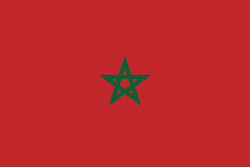Figuig (Figuig (Centre))
Figuig or Figig (فجيج; Figuig Berber: Ifeyyey) is an oasis town in eastern Morocco near the Atlas Mountains, on the border with Algeria.
The town is built around an oasis of date palms, called Tazdayt, meaning "palm tree" in the Berber language, surrounded by rugged, mountainous wilderness. Modernization has somewhat raised the standard of living, and drawn much of the town's population away, so that it is now struggling to reach stability. Its population in 2014 was 10,872, down from a peak of 14,571 in 1982.
The Ksour Range is a mountainous area extending between Figuig and El Bayadh.
The majority population of Figuig speaks a Berber dialect, Figuig Berber, a Zenati variety including many Arabic elements. Some women speak only in this language, while men also speak Moroccan Arabic. Figuig Berber is understood by Berber speakers from the area of Aïn Sefra in the east to the Atlas in the west.
The Sanhaja have left their traces in the toponymy (the mountain, the pass and the village which bear the name of Zenaga are witnesses). In addition to Berber-speaking sedentary people, the population of the oases includes many "marabouts" who call themselves sharifs and have played an important role in social cohesion over the past centuries, softening feuds and quarrels between villages or within villages. A third element of the population is the Harratins gathered in Zenaga where they live in a particular neighborhood: Al-Hahda. They are workers of inferior status, responsible for the maintenance of the foggaras and, in general, the main agricultural works in the palm plantation. The descendants of slaves are often confused with the Harratins. The small Jewish Berber population, formerly gathered in the two mellahs of Zenaga and Udaghir, has practically disappeared. There were 5,000 subjects at the beginning of the twentieth century.
The town is built around an oasis of date palms, called Tazdayt, meaning "palm tree" in the Berber language, surrounded by rugged, mountainous wilderness. Modernization has somewhat raised the standard of living, and drawn much of the town's population away, so that it is now struggling to reach stability. Its population in 2014 was 10,872, down from a peak of 14,571 in 1982.
The Ksour Range is a mountainous area extending between Figuig and El Bayadh.
The majority population of Figuig speaks a Berber dialect, Figuig Berber, a Zenati variety including many Arabic elements. Some women speak only in this language, while men also speak Moroccan Arabic. Figuig Berber is understood by Berber speakers from the area of Aïn Sefra in the east to the Atlas in the west.
The Sanhaja have left their traces in the toponymy (the mountain, the pass and the village which bear the name of Zenaga are witnesses). In addition to Berber-speaking sedentary people, the population of the oases includes many "marabouts" who call themselves sharifs and have played an important role in social cohesion over the past centuries, softening feuds and quarrels between villages or within villages. A third element of the population is the Harratins gathered in Zenaga where they live in a particular neighborhood: Al-Hahda. They are workers of inferior status, responsible for the maintenance of the foggaras and, in general, the main agricultural works in the palm plantation. The descendants of slaves are often confused with the Harratins. The small Jewish Berber population, formerly gathered in the two mellahs of Zenaga and Udaghir, has practically disappeared. There were 5,000 subjects at the beginning of the twentieth century.
Map - Figuig (Figuig (Centre))
Map
Country - Morocco
 |
 |
| Flag of Morocco | |
In a region inhabited since the Paleolithic era over 300,000 years ago, the first Moroccan state was established by Idris I in 788. It was subsequently ruled by a series of independent dynasties, reaching its zenith as a regional power in the 11th and 12th centuries, under the Almoravid and Almohad dynasties, when it controlled most of the Iberian Peninsula and the Maghreb. In the 15th and 16th centuries, Morocco faced external threats to its sovereignty, with Portugal seizing some territory and the Ottoman Empire encroaching from the east. The Marinid and Saadi dynasties otherwise resisted foreign domination, and Morocco was the only North African nation to escape Ottoman dominion. The 'Alawi dynasty, which rules the country to this day, seized power in 1631, and over the next two centuries expanded diplomatic and commercial relations with the Western world. Morocco's strategic location near the mouth of the Mediterranean drew renewed European interest; in 1912, France and Spain divided the country into respective protectorates, reserving an international zone in Tangier. Following intermittent riots and revolts against colonial rule, in 1956, Morocco regained its independence and reunified.
Currency / Language
| ISO | Currency | Symbol | Significant figures |
|---|---|---|---|
| MAD | Moroccan dirham | د م. | 2 |
| ISO | Language |
|---|---|
| AR | Arabic language |
| FR | French language |















